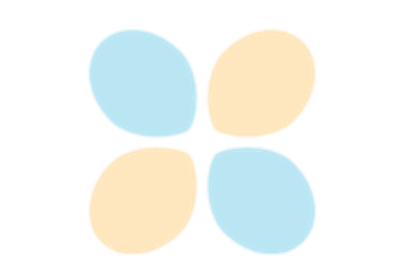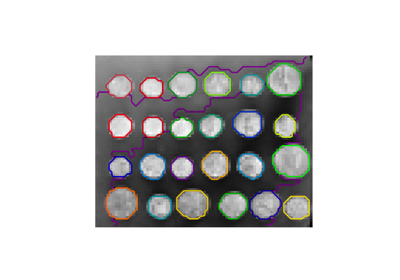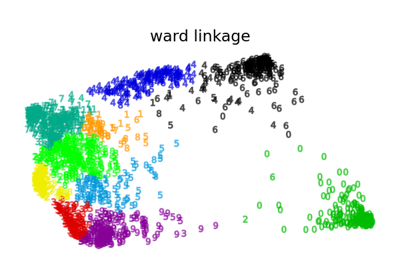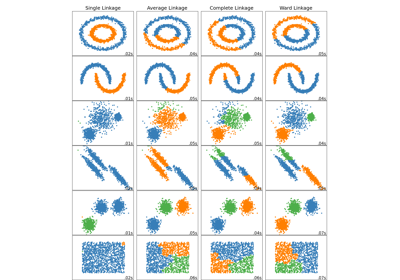注意
转到末尾以下载完整示例代码,或通过 JupyterLite 或 Binder 在浏览器中运行此示例。
归纳式聚类#
聚类可能非常耗时,尤其是当我们的数据集包含数百万个数据点时。许多聚类算法不是归纳式的,因此无法在不重新计算聚类的情况下直接应用于新的数据样本,而重新计算聚类可能是难以处理的。相反,我们可以使用聚类来学习一个归纳式模型,即一个分类器,这有几个好处:
它允许聚类扩展并应用于新数据
与重新拟合新样本的聚类不同,它确保了标记过程随时间保持一致
它允许我们使用分类器的推断能力来描述或解释聚类
本示例展示了一个元估计器的通用实现,它通过从聚类标签中归纳出一个分类器来扩展聚类。
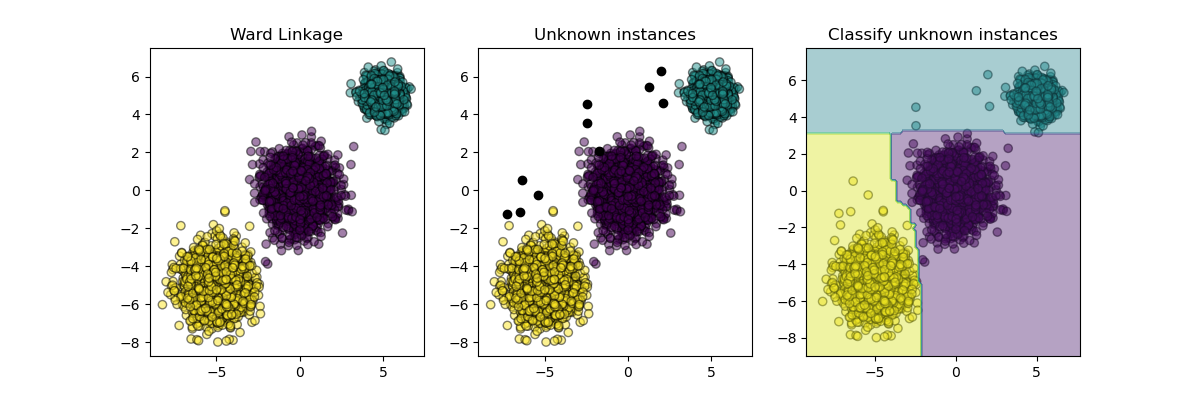
# Authors: The scikit-learn developers
# SPDX-License-Identifier: BSD-3-Clause
import matplotlib.pyplot as plt
from sklearn.base import BaseEstimator, clone
from sklearn.cluster import AgglomerativeClustering
from sklearn.datasets import make_blobs
from sklearn.ensemble import RandomForestClassifier
from sklearn.inspection import DecisionBoundaryDisplay
from sklearn.utils.metaestimators import available_if
from sklearn.utils.validation import check_is_fitted
N_SAMPLES = 5000
RANDOM_STATE = 42
def _classifier_has(attr):
"""Check if we can delegate a method to the underlying classifier.
First, we check the first fitted classifier if available, otherwise we
check the unfitted classifier.
"""
return lambda estimator: (
hasattr(estimator.classifier_, attr)
if hasattr(estimator, "classifier_")
else hasattr(estimator.classifier, attr)
)
class InductiveClusterer(BaseEstimator):
def __init__(self, clusterer, classifier):
self.clusterer = clusterer
self.classifier = classifier
def fit(self, X, y=None):
self.clusterer_ = clone(self.clusterer)
self.classifier_ = clone(self.classifier)
y = self.clusterer_.fit_predict(X)
self.classifier_.fit(X, y)
return self
@available_if(_classifier_has("predict"))
def predict(self, X):
check_is_fitted(self)
return self.classifier_.predict(X)
@available_if(_classifier_has("decision_function"))
def decision_function(self, X):
check_is_fitted(self)
return self.classifier_.decision_function(X)
def plot_scatter(X, color, alpha=0.5):
return plt.scatter(X[:, 0], X[:, 1], c=color, alpha=alpha, edgecolor="k")
# Generate some training data from clustering
X, y = make_blobs(
n_samples=N_SAMPLES,
cluster_std=[1.0, 1.0, 0.5],
centers=[(-5, -5), (0, 0), (5, 5)],
random_state=RANDOM_STATE,
)
# Train a clustering algorithm on the training data and get the cluster labels
clusterer = AgglomerativeClustering(n_clusters=3)
cluster_labels = clusterer.fit_predict(X)
plt.figure(figsize=(12, 4))
plt.subplot(131)
plot_scatter(X, cluster_labels)
plt.title("Ward Linkage")
# Generate new samples and plot them along with the original dataset
X_new, y_new = make_blobs(
n_samples=10, centers=[(-7, -1), (-2, 4), (3, 6)], random_state=RANDOM_STATE
)
plt.subplot(132)
plot_scatter(X, cluster_labels)
plot_scatter(X_new, "black", 1)
plt.title("Unknown instances")
# Declare the inductive learning model that it will be used to
# predict cluster membership for unknown instances
classifier = RandomForestClassifier(random_state=RANDOM_STATE)
inductive_learner = InductiveClusterer(clusterer, classifier).fit(X)
probable_clusters = inductive_learner.predict(X_new)
ax = plt.subplot(133)
plot_scatter(X, cluster_labels)
plot_scatter(X_new, probable_clusters)
# Plotting decision regions
DecisionBoundaryDisplay.from_estimator(
inductive_learner, X, response_method="predict", alpha=0.4, ax=ax
)
plt.title("Classify unknown instances")
plt.show()
脚本总运行时间: (0 分钟 1.972 秒)
相关示例
